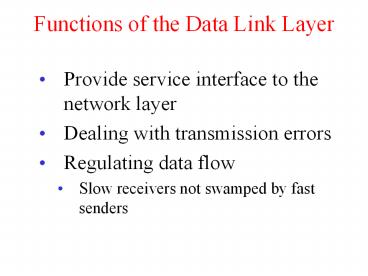Functions of the Data Link Layer - PowerPoint PPT Presentation
Title:
Functions of the Data Link Layer
Description:
... is represented as a polynomial of degree k in some dummy variable, with ... Polynomial arithmetic is done modulo 2 (no carries or borrows, GF(2)) CRC Codes ... – PowerPoint PPT presentation
Number of Views:33
Avg rating:3.0/5.0
Title: Functions of the Data Link Layer
1
Functions of the Data Link Layer
- Provide service interface to the network layer
- Dealing with transmission errors
- Regulating data flow
- Slow receivers not swamped by fast senders
2
Functions of the Data Link Layer (2)
- Relationship between packets and frames.
3
Errors in transmission
- Basics of transmission variation of
(amplitude/phase/frequency) - SNR
- 10 log ((peak signal/(RMS Noise)2)
- Regenerative Repeaters
- Bit Error Ratio (BER)
- Optical medium is around 10-14
- Wireless is around 10-3
- Copper in between
- Gaussian Noise/AWGN
- Burst errors
4
Error Detection and Correction
- Error-Correcting, Error-Detecting Codes
- Some Basics
- Msg (m) Redundant(r) Code(n)
- Not all codewords are legal
- Hamming Distance is the number of positions where
two codewords differ - If 2 codewords are distance d apart, then it
takes d errors to convert one to the other gt - d1 distance for d error detection
- 2d1 distance for d error correction
5
Error Detection and Correction
- Parity as an EDC
- 1 bit parity creates a code with distance 2
- 00 --gt 000, 01 --gt 011
- Suppose we want to correct all single errors in
an m bit message. How efficient can such a code
be in terms of length ? - n bit code gt n single bit errors gt n1
codes/valid msg - (n1)2m lt 2n or mr1 lt 2r
6
Hamming Codes
- Hamming codes obtain the theoretical lower bounds
(perfect parity codes) - In a codeword, powers of 2 are the check bits,
and the other bits contain data - The parity of a data bit is checked by several
check bits, as directed by the binary
representation of its position. - Bit 11s parity is checked by 128
- Reciever adds parity bits in error, and this
gives the location of the error bit! - Interleaving to detect burst errors
7
Error-Correcting Codes
- Use of a Hamming code to correct burst errors.
8
Error Detecting Codes
- Useful when BERs are low and overhead of ECC is
significant compared to Re-Tx. - Still use the interleaving idea to convert burst
errors into single bit errors - Polynomial (CRC) codes
- A k1 bit number is represented as a polynomial
of degree k in some dummy variable, with leftmost
bit being most significnt. - Sender and receiver agree on the generator of
the code, another polynomial G(x), with 1s in msb
and lsb - Polynomial arithmetic is done modulo 2 (no
carries or borrows, GF(2))
9
CRC Codes
- Append a checksum to the end of the msg
- If G(x) is of degree r, then append r 0s to end
of the m msg bits. The new number is now xrM(x) - Divide this by G(x) modulo 2
- Subtract the remainder from XrM(x) modulo 2, and
let this be T(x). This number is now divisible by
G(x) - Transmit T(x), and have receiver check if the
received data is divisible by G(x) - Suppose T(x)E(x) arrives.
- (T(x)E(x)/G(x) ) E(x)/G(x)
- Detection whenever E(x)/G(x) ! 0
10
Error detection in CRC
- 1 bit error will be caught as long as G has 2 or
more terms - For 2 isolated bit errors if G(x) does not divide
xk1 where k distance between error bits - CRC-CCITT 1x5 x12 x16
- IEEE 802 (32,26,23,22,16,12,11,10,8,7,5,4,2,1,0)
- BCH Codes are GF(2m). Reed-Solomon are BCH codes
with block size 2m - Convolution codes (Trellis or Viterbi)
11
Error-Detecting Codes
Calculation of the polynomial code checksum.































